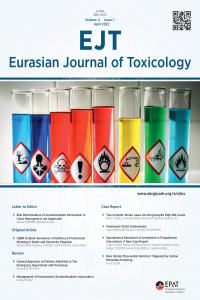Reversible Splenial Corpus Callosum Lesion and Carbamazepine
Anahtar Kelimeler:
Reversible Splenial Corpus Callosum Lesion
Reversible Splenial Corpus Callosum Lesion and Carbamazepine
Introductıon
Reversible splenial lesion syndrome (RESLES) at corpus callosum (CC) has been defined in many clinical conditions. Although the etiopathogenesis of transient focal lesions in the CC splenium has not been clarified, many theories remain on the agenda, especially in epilepsy patients.
Case
A 38-year-old male patient with idiopathic generalized epilepsy was admitted to the emergency department with complaints of frequent seizures. It was reported by his relatives that he had stopped carbamazepine treatment for the last three days. After his last epileptic attack, he had been headache, nausea, vomiting, decreased visual acuity, and prolonged confusion. The patient with diffusion restriction at the level of splenium CC in magnetic resonance imaging (MRI), whose seizure frequency increased, was evaluated by a neurology doctor. In his electroencephalography, spike waves were observed in both hemispheres, which were frequently generalized. The same lesion was not observed in the diffusion and MRI taken eight days later in the patient who had no seizures in the follow-up.
Discussion
Studies have shown that CC damage results in the disruption of cortical functions, with disconnection of the cerebral hemispheres and disturbances in consciousness. The clinical spectrum includes a fairly wide symptomatology. RESLES of the CC is an infrequent finding on MRI. Some of these lesions are associated with epileptic seizures, the sudden withdrawal of the antiepileptic drug, or usage.
Conclusion
RESLES, which we reviewed with etiology and clinical findings, still remains a mystery. It will be clarified with wide-ranging studies.
___
- Tetsuka S. Reversible lesion in the splenium of the corpus callosum. Brain Behav. 2019 9;e01440. 10.1002/brb3.1440 .
- Jing C, Sun L, Wang Z, et al. Reversible splenial lesion syndrome due to oxcarbazepine withdrawal: case report and literature review. J Int Med Res. 2018; 46: 1277-1281.
- Blaauw J, Meiners LC. The splenium of the corpus callosum: Embryology, anatomy, function, and imaging with pathophysiological hypothesis. Neuroradiology 2020;62:563–585.
- Notebaert A, Willems J, Coucke L, et al. Expanding the spectrum of MERS type 2 lesions, a particular form of encephalitis. Pediatr Neurol. 2013; 48: 135-138.
- Zhang S, Ma Y, Feng J. Clinicoradiological spectrum of reversible splenial lesion syndrome (RESLES) in adults: a retrospective study of a rare entity. Medicine (Baltimore) 2015;94: e512.
- Yuan J, Yang S, Wang S, et al. Mild encephalitis/encephalopathy with reversible splenial lesion (MERS) in adults-a case report and literature review. BMC Neurol. 2017; 17: 103.
- Dong K, Zhang Q, Ding J, et al. Mild encephalopathy with a reversible splenial lesion mimicking transient ischemic attack: a case report. Medicine (Baltimore) 2016; 95: e5258.
- Lu PI, Hodes JF, Zheng X, et al. Reversible Splenial Lesion Syndrome with Some Novel Causes and Clinical Manifestations. Intern. Med. 2020;59, 2471–2480.
- Tada H, Takanashi J, Barkovich AJ, et al. Clinically mild encephalitis/encephalopathy with a reversible splenial lesion. Neurology 2004;63(10): 1854-1858. PMID: 15557501. DOI: 10.1212/01.wnl.0000144274.12174.cb
- Gurtler S, Ebner A, Tuxhorn I, et al. Transient lesion in the splenium of the corpus callosum and antiepileptic drug withdrawal. Neurology 2005;65:1032–1036. Prilipko O, Delavelle J, Lazeyras F, et al. Reversible cytotoxic edema in the splenium of the corpus callosum related to antiepileptic treatment: report of two cases and literature review. Epilepsia 2005;46: 1633-1636.
- Doherty MJ, Jayadev S, Watson NF, et al. Clinical implications of splenium magnetic resonance imaging signal changes. Arch Neurol 2005;62: 433-437.
- Öztoprak İ, Engin A, Gümüs C, et al. Transient splenial lesions of the corpus callosum in different stages of evolution. Clin Radiol 2007;62: 907-913.
- Da Rocha AJ, Reis F, Gama HP, et al. Focal transient lesion in the splenium of the corpus callosum in three non-epileptic patients. Neuroradiology 2006;48(10): 731-735.
- Kim JH, Choi JY, Koh SB, et al. Reversible splenial abnormality in hypoglycemic encephalopathy. Neuroradiology 2007;49(3): 217-222.
- Sawagashira R, Narita H, Hashimoto N, et al. Transient lesions of the splenium of the corpus callosum following rapid withdrawal of levetiracetam. Epileptic Disord 2017;19: 379- 382.
- Förster A, Apfaltrer P, Al-Zghloul M, et al. Diffusion Restricted Lesions in the Splenium of the Corpus Callosum. In vivo 2022: 36: 1354-1359
- Yayın Aralığı: Yılda 3 Sayı
- Başlangıç: 2019
- Yayıncı: Acil Tıp Uzmanları Derneği
Sayıdaki Diğer Makaleler
Orhan DELİCE, Murat DAŞ, Gülhan KURTOĞLU ÇELİK, Havva ŞAHİN KAVAKLI, Salim NEŞELİOĞLU, Semra IŞIKOĞLU HATIL
Datura Zehirlenmesi ile Acile Başvuran 7 Kardeş: Kuzey Suriye’den Olgular
Bahadır KARACA, Burak ÇELİK, Murat TEPE, Buğra YILDIRIM
Alüminyum Fosfit Zehirlenmesine Bağlı Hızla Gelişen Ölüm
Kalsiyum Asetat Alımı Sonrası Dilde Olağandışı Aşırı Şişlik: Olgu Sunumu
Reversible Splenial Corpus Callosum Lesion and Carbamazepine
